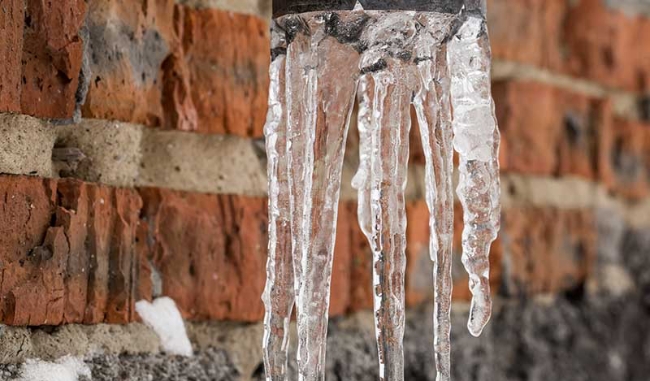Essential Tips to Prevent Frozen Pipes in Cold Weather: Professional Guidance
Essential Tips to Prevent Frozen Pipes in Cold Weather: Professional Guidance
Blog Article
We've come across this post pertaining to Winter Plumbing Precautions: Preventing Frozen Pipes directly below on the internet and felt it made sense to discuss it with you in this article.

Cold weather can damage your plumbing, particularly by freezing pipelines. Right here's exactly how to stop it from taking place and what to do if it does.
Intro
As temperatures decline, the danger of icy pipes rises, possibly bring about pricey fixings and water damage. Comprehending how to prevent frozen pipes is important for property owners in cold environments.
Prevention Tips
Insulating prone pipes
Cover pipelines in insulation sleeves or use warmth tape to protect them from freezing temperatures. Concentrate on pipelines in unheated or exterior areas of the home.
Heating techniques
Keep interior spaces sufficiently heated, especially locations with plumbing. Open up closet doors to permit warm air to circulate around pipes under sinks.
Exactly how to determine icy pipes
Search for reduced water flow from faucets, unusual smells or sounds from pipelines, and visible frost on subjected pipelines.
Long-Term Solutions
Structural modifications
Think about rerouting pipes far from exterior wall surfaces or unheated areas. Add extra insulation to attics, cellars, and crawl spaces.
Updating insulation
Invest in top quality insulation for pipes, attics, and wall surfaces. Appropriate insulation helps preserve constant temperatures and lowers the danger of icy pipelines.
Shielding Outdoor Pipes
Garden hose pipes and outside faucets
Separate and drain garden hoses before winter. Mount frost-proof spigots or cover outdoor faucets with shielded caps.
Recognizing Icy Pipelines
What triggers pipes to ice up?
Pipes ice up when exposed to temperature levels below 32 ° F (0 ° C) for prolonged durations. As water inside the pipes ices up, it broadens, putting pressure on the pipe wall surfaces and potentially triggering them to rupture.
Risks and damages
Frozen pipelines can cause water system disturbances, property damage, and pricey repair work. Ruptured pipelines can flooding homes and cause substantial structural damages.
Indicators of Frozen Pipes
Recognizing frozen pipes early can prevent them from bursting.
What to Do If Your Pipes Freeze
Immediate activities to take
If you presume icy pipes, keep taps available to alleviate pressure as the ice melts. Utilize a hairdryer or towels taken in warm water to thaw pipes slowly.
Final thought
Stopping icy pipelines requires positive actions and fast reactions. By recognizing the reasons, signs, and preventive measures, house owners can safeguard their plumbing throughout winter.
5 Ways to Prevent Frozen Pipes
Drain Outdoor Faucets and Disconnect Hoses
First, close the shut-off valve that controls the flow of water in the pipe to your outdoor faucet. Then, head outside to disconnect and drain your hose and open the outdoor faucet to allow the water to completely drain out of the line. Turn off the faucet when done. Finally, head back to the shut-off valve and drain the remaining water inside the pipe into a bucket or container. Additionally, if you have a home irrigation system, you should consider hiring an expert to clear the system of water each year.
Insulate Pipes
One of the best and most cost-effective methods for preventing frozen water pipes is to wrap your pipes with insulation. This is especially important for areas in your home that aren’t exposed to heat, such as an attic. We suggest using foam sleeves, which can typically be found at your local hardware store.
Keep Heat Running at 65
Your pipes are located inside your walls, and the temperature there is much colder than the rest of the house. To prevent your pipes from freezing, The Insurance Information Institute suggests that you keep your home heated to at least 65 degrees, even when traveling. You may want to invest in smart devices that can keep an eye on the temperature in your home while you’re away.
Leave Water Dripping
Moving water — even a small trickle — can prevent ice from forming inside your pipes. When freezing temps are imminent, start a drip of water from all faucets that serve exposed pipes. Leaving a few faucets running will also help relieve pressure inside the pipes and help prevent a rupture if the water inside freezes.
Open Cupboard Doors
Warm your kitchen and bathroom pipes by opening cupboards and vanities. You should also leave your interior doors ajar to help warm air circulate evenly throughout your home.

Do you appreciate reading about How to Prevent Your Pipes From Freezing? Post feedback down the page. We will be happy to listen to your opinion about this write-up. Hoping that you visit us again in the future. Kindly pause to promote this article if you liked it. Many thanks for taking the time to read it.
Click On This Link Report this page